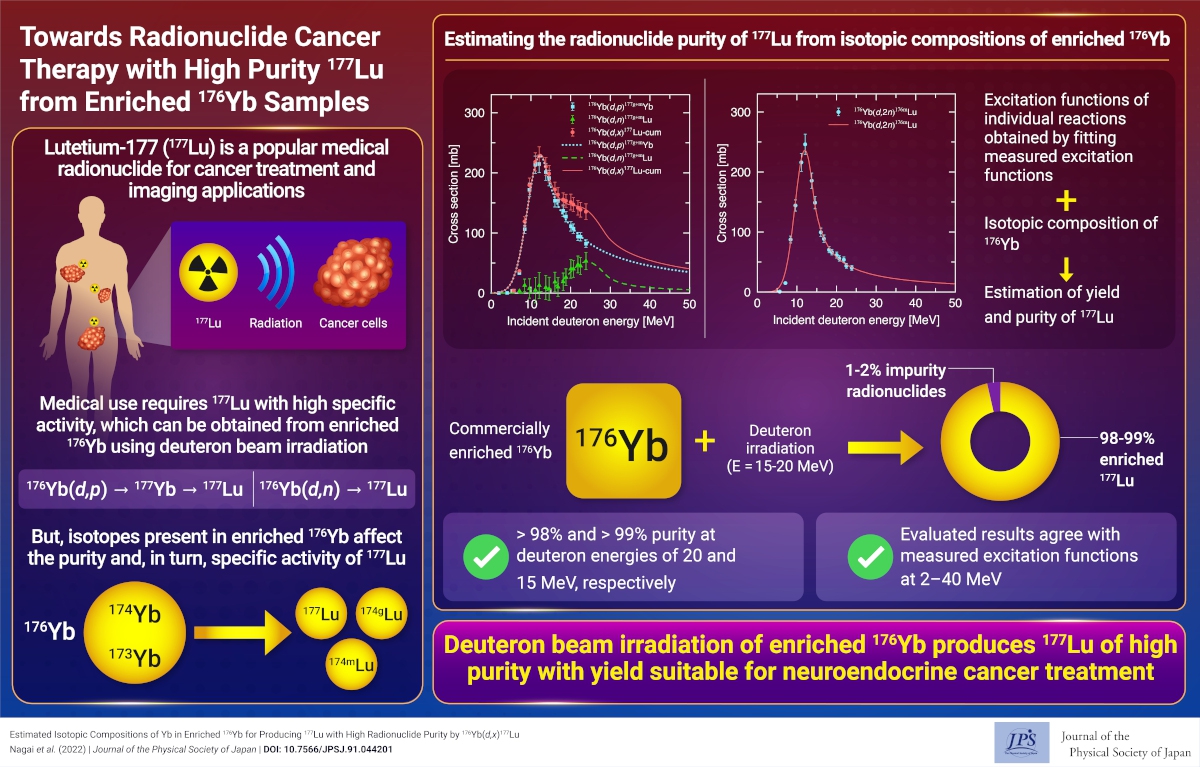Towards Radionuclide Cancer Therapy with High Purity 177Lu from Enriched 176Yb Samples
© The Physical Society of Japan
This article is on
Estimated Isotopic Compositions of Yb in Enriched 176Yb for Producing 177Lu with High Radionuclide Purity by 176Yb(d,x)177Lu
(JPSJ Editors' Choice)
J. Phys. Soc. Jpn. 91, 044201 (2022).
A method was developed to estimate the isotopic compositions of enriched 176Yb sample required for producing radionuclide 177Lu used for cancer therapy, with high radionuclide purity in accelerators.

Radiopharmaceuticals labelled with radionuclides of high radionuclide purity in nuclear medicine that emit gamma-rays and beta-rays have been used for diagnosis imaging of diseases and therapy in cancer treatments, respectively. Internal radiation therapy is performed using radiation doses to kill cancer cells and shrink tumors. A personalized medicine treatment that combines diagnosis and therapy has become important for a patient, in which information about the patient’s genes is used. A personalized medicine treatment is performed using radionuclide pairs appropriate for both diagnosis and therapy in the same patients, requiring us to develop a variety of radionuclides.
Recently, significant interest has arisen in 177Lu, currently produced in reactors, owing to successful treatments in patients with neuroendocrine tumors, which appear everywhere in the body, using 177Lu-labelled radiopharmaceuticals; this success encourages further study of 177Lu production in accelerators toward widespread medical applications of 177Lu. Indeed, the excitation functions of the 176Yb(d,p)177Yb®177Lu and 176Yb(d,n)177Lu (hereafter 176Yb(d,x)177Lu) reaction have been measured using a natural Yb (natYb) sample but not an enriched 176Yb sample. Hence, radionuclide purity of 177Lu radionuclide is low because of many impurity radionuclides of Lu arising from seven stable isotopes, 168Yb-176Yb, present in natYb. Even with the use of highly enriched samples, no radionuclide sample is 100% pure and all contain some impurity radionuclides resulting from the production process by nuclear reactions.
A method was developed to estimate the isotopic compositions of enriched 176Yb samples required to produce 177Lu with a high radionuclide purity using the 176Yb(d,x)177Lu reaction. First, the estimation was done by deriving excitation functions of individual reactions for producing all aforementioned impurity Lu radionuclides that were obtained by fitting the measured excitation functions of the natYb(d,x)Lu reactions with an appropriate function form (see Fig. 1). Second, the yields of all Lu radionuclides that were produced by irradiating enriched 176Yb samples with several isotopic compositions of Yb present in enriched 176Yb samples with deuteron beams were estimated. The 177Lu radionuclide purity for the 99.90% and 97.60% enriched 176Yb samples at 2.5 days after the end of irradiation was estimated to be high, that is, > 98% and > 99% at the deuteron energy of 20 and 15 MeV, respectively. The resultant radionuclide 177Lu would play an important role in promoting its widespread use for a variety of therapeutic applications. This finding to utilize measured excitation functions of nuclear reactions with natural samples would play an important role in producing a variety of medical radionuclides with a high radionuclide purity.
(written by Yasuki Nagai on behalf of all authors)

Fig.1.
(Left) Measured and fitted excitation functions of the 176Yb(d,2n)176mLu reaction. (Middle) Measured excitation functions of the 176Yb(d,p)177g+mYb (filled squares), 176Yb(d,n)177Lu (filled triangle), and 176Yb(d,x)177Lu (cumulative. filled circles) reactions. The fitted excitation functions of the reactions are shown by the solid, dotted, and dashed lines.
(Right) Measured (filled circles) and fitted (solid, dotted, and dashed lines) excitation function of the natYb(d,x)174g+mLu reaction.
Estimated Isotopic Compositions of Yb in Enriched 176Yb for Producing 177Lu with High Radionuclide Purity by 176Yb(d,x)177Lu
(JPSJ Editors' Choice)
J. Phys. Soc. Jpn. 91, 044201 (2022).
Share this topic
Fields
Related Articles
-
Which is Moving?—Pinning Down the Origin of Fluctuations in Muon Spin Relaxation—
Structure and mechanical and thermal properties in condensed matter
Cross-disciplinary physics and related areas of science and technology
2024-3-28
The study demonstrated that we can distinguish between the diffusion motion of the muon itself and the motion of the surrounding ions in muon spin relaxation.
-
Thermodynamic Property of a CMOS Device beyond Landauer Limit
Statistical physics and thermodynamics
Electronic transport in condensed matter
Cross-disciplinary physics and related areas of science and technology
2024-1-23
Focusing on a CMOS NAND GATE operating in a sub-threshold region, the thermodynamic cost of computation was analyzed in relation to input/output voltages surpassing the Landauer limit.
-
Possible Origin of High Thermoelectric Power Factor in Ultrathin FeSe: A Two-band Model
Electronic structure and electrical properties of surfaces and nanostructures
Structure and mechanical and thermal properties in condensed matter
Cross-disciplinary physics and related areas of science and technology
2023-12-21
The high thermoelectric power factor observed in ultrathin FeSe can be theoretically explained by a two-band model with chemical potential between upper and lower band bottoms.
-
Exploring Recent Advances in the Physics of Biofluid Locomotion
Measurement, instrumentation, and techniques
Cross-disciplinary physics and related areas of science and technology
Electromagnetism, optics, acoustics, heat transfer, and classical and fluid mechanics
Statistical physics and thermodynamics
Mathematical methods, classical and quantum physics, relativity, gravitation, numerical simulation, computational modeling
Structure and mechanical and thermal properties in condensed matter
2023-12-8
This Special Topics Edition of the JPSJ describes the latest advances in the field of biofluid locomotion, shedding light on the underlying physics behind the movement of organisms that swim and fly.
-
Highly Accurate Estimation of Beta Decay Rates for Heavy Nuclei
Nuclear physics
2023-11-7
Physicists from Japan present complete formulas that consider the induced current and velocity-dependent terms for estimating the beta decay rates in heavy nuclei with high accuracy.
